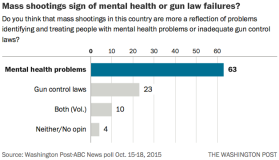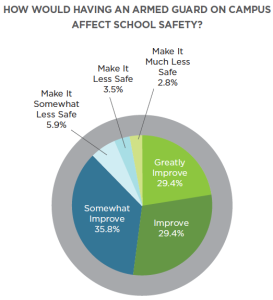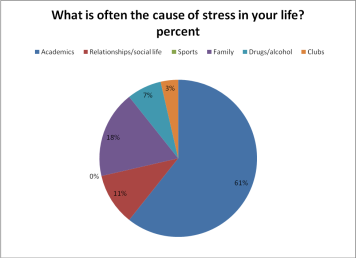One of the overlying questions of our EDU275 class at Colorado State University, is “what is the purpose of education?” On a superficial level, one could say it is to better society. But is is really bettering society when America is averaging one school shooting per week since 2013? The most recent one happened May 6th, 2016; just five days ago. Now, the last shooting in a school may have been an accidental one, but the other 181 shootings since 2013 have not been.
When the Columbine incident happened, most of the students our age were four or five years old when it happened. It’s a faint memory to some, if any at all to those who didn’t grow up in Colorado. Since that shooting in 1999, school shootings have been a popular trend. So what has changed in our education system to make these shootings a more frequent thing? Could it be the changed curriculum? Many students in high school couldn’t get help with their homework at home because their parents never learned the same information, even in college. Many high school students spend hours a night during high school doing homework, after sports practices and extracurricular activities, only to get up by 5:30am to do it all over again. In college, that schedule doesn’t improve much. Holding jobs and juggling challenging classes all while studying until 6:00am puts you in a bad mental health state, there is no question about that. Some people are obviously better at handling this type of stress than others, but what is that last little “trigger” that makes people want to pull the trigger?
When looking at shootings, many gun-rights activists like to make the claim that shooters tend to be people who don’t go to the school. Sandy Hook is an example of that, and one they like to use frequently. What people don’t realize is that all shooters who weren’t current students of that school, have a connection to it. In Sandy Hook, Adam Lanza attended the elementary school there. In a report by Huffington Post, they interviewed a family member who said, “Adam was never the same after his time at Sandy Hook as a kid. He would come home constantly covered in deep tissue bruises. When his mom would ask about them, he would just sit there and ignore her.” Abuse at such a young age impacts students differently. In Adam’s case, he held on to that grudge well into adulthood. Whatever actually happened at Sandy Hook during his childhood, we may never actually know, but what we do know is that the media likes to pin mental illness on school shooters.
How does this impact those who do have these diagnosed mental illnesses, who don’t shoot up schools? Coming from a personal stance, hearing them say “the shooter must have been severely depressed, always suffering from anxiety, was abused and bullied as a kid” and other excuses, is frustrating. Many of us have faced these issues to a great extent as well, but on the contrary have not similarly had the thought to execute a mass shooting within a school. Hearing them pin these things on people as an excuse for their actions only makes those who are actually suffering from these type of mental illnesses fear and hate themselves more. In reality, many of the shooters who happen to survive, or get caught before they kill, suffer from more than just severe depression. They express sociopathic tendencies (these tend to not get caught before they shoot because sociopaths tend to kill or commit crimes haphazardly or unorganized) or psychopathic tendencies (like Columbine, which wa s intricately planned and thought out beforehand). These two mental illnesses alone have no relation to depression or other mental illnesses. Other mental illnesses require some form of feelings or empathy for others and morals; being psychopathic or a sociopathic means those feelings are absent.
s intricately planned and thought out beforehand). These two mental illnesses alone have no relation to depression or other mental illnesses. Other mental illnesses require some form of feelings or empathy for others and morals; being psychopathic or a sociopathic means those feelings are absent.
At Umpqua Community College in Oregon, they believe the shooter’s motive was a religious one. All of the survivors recall him asking everyone to stand up, say if they were Christian or not, and if they responded yes, he would say, “Good, you’re about to meet God in one second.” The shooter also was heard saying to the teacher of that class, “I’ve been waiting to do this for years.” This is a clear example of a psychopathic tendency. The media needs to stop putting your everyday mental illnesses onto these shooters who clearly have something deeper going on inside their head.
So, how does this relate to stress management? Well, 15-25% of students have admitted to having depression and suicidal tendencies related to stress from school. Those people who have these deeper illnesses tend to fit in and seem like your average student. They might be a little quirky and not have many friends or keep to themselves, but they don’t ever really express many signs that are different from your average stressed-out student. However, if you add an immense amount of stress to students who are unrecognized psychopaths or sociopaths and give them a reason to hate a whole group of people or a whole school (like a bully or a teacher that has mistreated them), the outcome will never be one that is desired. An assumption is often made that people do this just for attention; to copycat the other shootings. More often than not, these shooters end up killing themselves too. They don’t ever get to see the “attention” people claimed they were trying to get. They had a motive, fulfilled it, and could die “happy”.
So what are our other concerns? When it comes to modern day schooling it seems the hot topic nowadays is “When will be the next school shooting?” This stress brings with it logistical issues that the administration must deal with. Two particular issues in question regard firearms education and having armed personnel in schools. When it comes to the issue of firearms education it seems that this is one of the only facets of the gun debate that receives bipartisan support. One thing to consider is that Firearms education isn’t a new thing. For example, the NRA’s Eddie Eagle program has been used in over 26,000 schools since its beginning in 1988, the primary goal being to teach kids pre-k through third grade to stay away from firearms and to inform an adult if there is an unattended and potentially dangerous firearm. However, many concerns come out when in regards to the perspective of the course. While firearms safety has support from both sides, the pro gun control side voiced concerns that teaching students how to handle firearms at an older age such as marksmanship courses and hunter safety courses encourages the ownership of firearms which they disagree with at this particular age group. This is a conundrum where we must ask “What is the purpose of education in the united states?” Do we teach our youth how to avoid firearms – which is a huge part of culture – or do we encourage the use of a tool that can potentially cause injury and death?
Another issue facing schools administration is the issue of armed security. Do they not have any and risk being unprepared during a live shooter situation, or do they stray from being underprepared and have armed security? With places like Douglas County investing several thousands of taxpayer dollars in semi automatic rifles and private security forces, one must ask why administration feels the need? They have to take into account how the armed security may increase stress of students and tensions in school s. Wayne Lapierre, the head of the NRA has made many bold calls for an increased presence of armed guards in schools to help prevent tragedies such as Newtown and Columbine. However critics of this challenge the idea that this call is both too simplistic, and that having police in schools may negatively affect the school-prison pipeline theory, suggesting that more officers in schools would lead to an increase in youths ending up in prison. On the contrary, there are many surveys taken by parents from various school districts suggesting that a large majority of parents believe that increased security within schools would be beneficial. For example, this can be seen in the graph we have included to the right.
s. Wayne Lapierre, the head of the NRA has made many bold calls for an increased presence of armed guards in schools to help prevent tragedies such as Newtown and Columbine. However critics of this challenge the idea that this call is both too simplistic, and that having police in schools may negatively affect the school-prison pipeline theory, suggesting that more officers in schools would lead to an increase in youths ending up in prison. On the contrary, there are many surveys taken by parents from various school districts suggesting that a large majority of parents believe that increased security within schools would be beneficial. For example, this can be seen in the graph we have included to the right.
One interesting point comes from David Fleishman, superintendent of the Newton Public Schools in Massachusetts. “To have an armed guard at every school completely sends the wrong message in so many ways about what schools are about.” What message does Fleishman think schools present? Having armed security guards would on one hand send a message of safety and protection, while on the other hand it would be a sad state of affairs if a preschool required an armed security force just so young kids could safely exercise their right to learn and pursue education. In the end, both of these issues affect how educational institutions will be handled in the future and affect various students’ stress levels differently.
The last issue we looked at was the correlation between stress and homework. How does the quality and quantity of the homework impacts students stress level? We took into account some personal experiences of high school students from different perspectives and discovered some interesting information. On particular high school sophomore mentioned that “When a teacher assigns homework incorporating information that was just recently taught or not taught at all, it puts a tremendous amount of stress on students.” Clearly, this shows that when teachers do not consider the appropriate quality and quantity of homework, they make the students feel stressed. This also tells us that she believed she had experienced an unfair and inappropriate assignment. Along with the personal effects, she also mentioned that homework put stress on parents, too. She pointed out how often times their homework assignments are too difficult to do by themselves. While this adds stress to parents trying to help their children, it can still be an even greater issue to certain students such as those who have no help at home. This in turn puts them at a total disadvantage and their grades might suffer due to this lack of assistance.
it can still be an even greater issue to certain students such as those who have no help at home. This in turn puts them at a total disadvantage and their grades might suffer due to this lack of assistance.
We realized that not only the quality and quantity of the homework, but also the home environment, are likely to be the factors of stress related to the homework. Considering these students who lack support outside of the classroom, perhaps an elongated “break” period should be incorporated into school time to enable students to get extra help from their teachers and possibly reducing some of their stress. But to majorly reduce stress from school, what can we do? What choices do we have? One idea was to require students to repeat a grade in which they were struggling to attempt to re-teach them the information they weren’t grasping. However, we found that this presents many negative aspects. One 9th grader mentioned that “when kids fall behind and have to repeat a grade, they can wind up in a vicious cycle of peer judgment and low self-esteem.”, which we recognize might increase stress as well. Jon Zaff, director of the Center for Promise at Tufts University, mentioned that being stigmatized both socially and academically leads students to think it is worthless to continue in school. He also mentioned that if people don’t think of the students as data points, but focus on the physical being of the students themselves, people would try to creatively construct ways to try to help them. Because schools tend to judge students mostly based off of test scores, stress levels are heightened even more. Perhaps this could be avoided and new approaches could be taken that focus on the student’s’ worth as a whole, not specifically their grades. This could be done through student interviews or evaluation of the growth of the students through portfolios. Some schools and teachers also often require homework to be turned in within just a day or two, so it might be helpful to students for teachers to reevaluate the timeframe of their assignments.
Unless we begin to provide support rather than just forming reasons as to why students behave the way they do, we are not going to see the results we want in the reduction of student stress levels. Because of the destructive effects stress causes, it is important that we address this issue fully. It also might be beneficial to the students to offer volunteer opportunities to people outside of schools that want to help students who may be lacking in their home environments. Parents, older students, alumni, etc. are some examples of additional helpful hands. The main way to effectively change school shootings and other violent, stress-induced acts is to start from the source, and personally helping these students might just be our best option.
